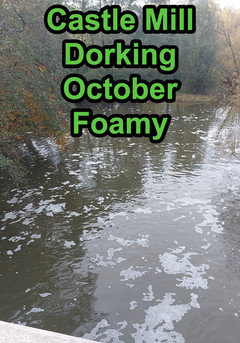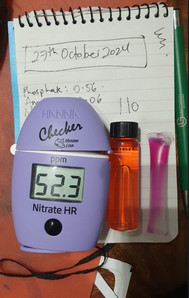October pollution results: What are the emerging pollution patterns in the River Mole after 18 months of citizen science?
- Nov 2, 2024
- 7 min read
Updated: Nov 3, 2024

The latest October test results reveal the now usual concerning array of hot spots of polluted water courses in the River Mole catchment. For this update, we look at the patterns emerging from the last 18 months of citizen science data collected every month at 33 sites on the River Mole.

Before we dive in to the data we must say another massive thank you to our incredible volunteer citizen scientists. Their efforts are building the most astonishing picture of river catchment pollution observations and data which is so important in working towards a better future for the River Mole .. thank you everyone (including the many not pictured here).
For this post we will explore the emerging patterns for each of the main pollutants we test: phosphate, nitrate and ammonia. If you enjoy this post and want to support our work PLEASE consider donating by using the button on this website. You can also leave a helpful comment or hit "Like" at the foot of this page.. it helps a lot having feedback. Thank you.
Phosphate pollution

Eighteen months of river test results allow us to see some strong emerging patterns and characteristics regarding phosphate concentration in different parts of the River Mole catchment. Four groups of streams with distinct characteristics appear to be emerging:
1: "Clean streams" in the Upper Mole include those with few tributaries known as "first order streams". These include water courses draining the watershed on the wooded hills surrounding Crawley such as Bewbush and Ifield Brook, Burstow Stream, Gatwick Stream and Man's Brook. These all feature low phosphate levels. (note: Burstow Stream at Peeks Brook, upstream of STW, should also be part of this group but the diagram is in downstream order so "wrongly" appears in Group 2).
2: Larger Upper Mole tributaries includes those with large sewage treatment works upstream such as Burstow Stream at Lake Lane, Redhill Brook, Salfords Stream, Earlswood Brook and Leigh Brook. These streams feature consistently high levels of phosphate. Other streams in this group drain predominantly rural agricultural land for example Hookwood Common Brook, Spencers Gill and Deanoak Brook.
3: Streams draining the North Downs chalk and the Surrey Hills sandstone form another distinct group of relatively low but variable phosphate. This includes streams with consistently low phosphate concentration such as Shag Brook but also some with relatively high phosphate concentrations such as The Rye. Shag Brook, arguably a chalk stream rising in the North Downs near Reigate, drains land through old gravel pits. The Rye has an urban catchment at its source with known problems of misconnections. This group also includes Wallace Brook which features consistently high ammonia concentration.
4: The main River Mole channel features high phosphate concentrations despite dilution from larger flow volumes compared to tributaries. While average concentration declines downstream there are notable seasonal differences in phosphate concentrations along the main channel as measured at sites such as West Vale at Horley, Castle Mill at Dorking and downstream to Leatherhead, Cobham and Molesey.
Seasonal concentrations in the charts below show an obvious marked maximums of phosphate concentration in all streams across the catchment in summer. This is due to low flow increasing concentration as effluent discharge forms a higher proportion of the volume. However, there are interesting changes in Group 4, the Lower Mole main channel, regarding trends downstream seasonally shown in the charts below.

In summer, there is a consistent downstream decline in phosphate concentration along the Lower Mole from highs at the Stepping Stones in Dorking to lower values at Ember and Molesey. In autumn and winter there is a less pronounced but noticeable increase in phosphate downstream. Spring seems to be a transition month with featuring both increases and decreases in phosphate concentration downstream. This appears to show the behaviour of phosphate concentration reverses seasonally downstream along the River Mole. These seasonal characteristics can also be detected in the chart below showing Upper Mole streams grouped for clarity.

Looking at trends over time, we continue to see a strong correlation between river level and phosphate concentration as shown in the chart below.

This month shows a slight uptick in average catchment phosphate ppm because precipitation in October, at 82mm, was somewhat below average and so flow in the river was subsequently lower than September. There is also a notable contrast with the much wetter month last year in October '23. This shows how phosphate concentration is closely linked to river discharge.

Phosphate levels in streams with sewage treatment works continue to be much higher than those without.

The scatter charts below show correlations related to phosphate levels and rainfall, riverflow and sewage overflows. The counterintuitive result showing storm overflow duration negatively correlated with phosphate concentration (ppm) is likely due to dilution from heavy rain, so phosphate levels appear to decrease despite longer duration raw sewage spills from storm tanks at treatment works. However, there is a stronger correlation between storm overflows and phosphate load (kg/h) which shows that river volume transports a higher phosphate load associated with such sewage discharges.

Overall, more than 50% of our tests at 33 sites over the last 18 months show a Poor or Bad water quality status while 80% of water courses fall into the inadequate Moderate-Poor-Bad criteria of the Water Framework Directive.


How reliable are our results?
By comparing the data from autumn 2023 to autumn 2024, we can see a striking similarity in the test results obtained at each river site shown below. This likely indicates our tests are picking up a seasonal characteristic baseline for pollution levels. Consequently, it implies our methodologies and tests are detecting genuine patterns in the natural environment which increases confidence in data reliability.

Although acute pollution incidents can lead to sudden spikes and anomalies in pollution levels, the data demonstrates a strong correlation between the corresponding time periods of the previous year, as illustrated in the autumn '23 to autumn '24 comparison below. This indicates that our citizen scientists are consistently employing rigorous test methods each month, yielding dependable outcomes from the Hanna test kits. Such findings instill confidence in our testers, methodologies, kits, and the emerging overall trends.

Nitrate Pollution
Although we only started testing nitrate in April and have just 7 months of data, the distribution of nitrate results already illustrates interesting emerging patterns. The map below shows our latest results from October which support these typical catchment patterns. High nitrate concentrations were found in tributaries with sewage treatment works such as Earlswood Brook while the main River Mole channel downstream of Horley also had consistently elevated concentrations of nitrate falling into Bad water quality (WQ) status at every test site downstream to the confluence with the Thames at Molesey. First order streams draining rural wooded land on the hilly watershed in the Upper Mole, for example Burstow Stream upstream of Burstow STW, Bewbush Brook and Shag Brook, all returned lower nitrate levels at High or Good WQ status.

Nitrate tests show similar groupings of streams to phosphate but with more polarisation of results towards the extremes. For example, in our October tests, 60% of streams fell into either of the most extreme categories with 36.4% of water courses rated as Bad and 24.2% recorded as High water quality based on nitrate.

Similar to our findings from phosphate tests, over the last 18 months the lowest nitrate concentrations have been found almost exclusively in first order streams especially those without large sewage treatment works. Streams achieving the High water quality status based on nitrate rise from wooded and rural land such as Shag Brook, Wallace Brook and Spencers Gill. Oddly, Wallace Brook has the highest levels of ammonia in the catchment and Spencers Gill occasionally very high levels of phosphate. Streams rising from the Worth Forest area in the watershed hills around Crawley such as Bewbush Brook and the Upper Mole feature consistently low nitrate concentration, falling into the Good water quality category overall.

Test sites downstream of sewage treatment works consistently record much higher nitrate concentrations compared to those without sewage treatment facilities. These include Burstow Stream downstream of Burstow sewage works, Leigh Brook downstream of Holmwood sewage works and Earlswood Brook downstream of Reigate sewage works.

These characteristics show up clearly on the chart showing patterns in nitrate levels downstream. The main River Mole channel from Horley to the confluence with the Thames at Molesey also features elevated nitrate levels most notably through the Mole Gap.

The chart below shows the impact of Dorking sewage treatment works on nitrate concentration. It appears to show how effluent discharge from the sewage works builds nitrate levels downstream along the main channel despite additional dilution from increased river flow. As shown in the chart above these levels are maintained for the whole length of the Lower Mole to the confluence with the Thames.

Monthly trends continue to show the yawning gap in nitrate levels between streams with sewage treatment works and those without.

Overall, 62.5% of streams in the catchment rate as Moderate-Poor-Bad water quality based on nitrate concentration.

Ammonia Pollution
Ammonia levels for October show results again polarised to a few extreme levels with Wallace Brook still returning the highest concentration in the catchment.

Like nitrate, we have 7 months of ammonia data but this is already showing strongly emerging trends of ammonia pollution downstream. Ammonia concentration is seen to decline consistently from highs in the Upper Mole and Dorking to lower levels in the Lower Mole.

Two tributaries, Spencers Gill in Hookwood and Wallace Brook in Reigate, dominate the ammonia story both returning extremely high levels from most monthly tests. Wallace Brook in particular holds the top slot with the most consistent levels of ammonia by far with an average of 1.80ppm compared to 0.96ppm for Spencers Gill. Most streams in the catchment average less than 0.50ppm with the overall average being 0.25ppm.

Ammonia levels are consistently lower in water courses downstream of sewage works. As explained in previous posts, this is likely due to ammonia being stripped effectively in the treatment of effluent which, especially in summer, forms a high proportion of the volume of flow in tributaries with STWs.

The Power of Citizen Science
Finally, we must say again thank you to our superb citizen scientists. Their work to ensure accurate and robust results is outstanding. They have a super attention to detail and follow methods assiduously. If they suspect an odd result they frequently re-test if not certain a test has gone to their satisfaction. They use the chat to ask questions and compare tests with others in the group. Our analysis of results show their efforts and attention to rigorous methods are yielding robust data.. tests are showing reliable consistency across months and where anomalies occur we can often explain these.
Thanks again everyone involved in River Mole River Watch. Our two year anniversary is approaching and will be worth marking in celebration of our community achievement so far if not a cleaner river..yet.






































Comentarios